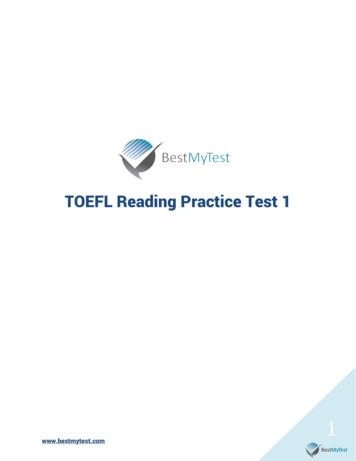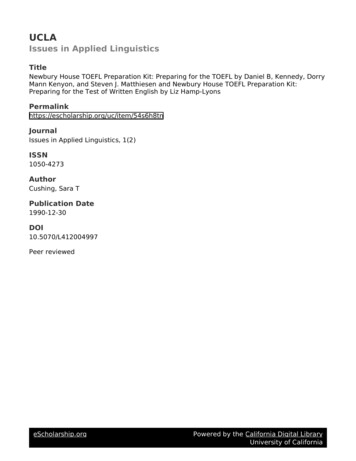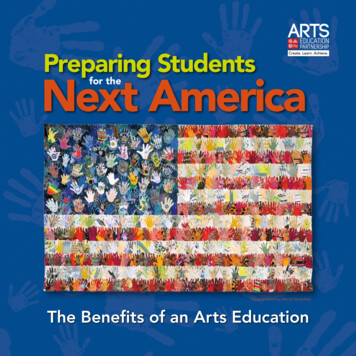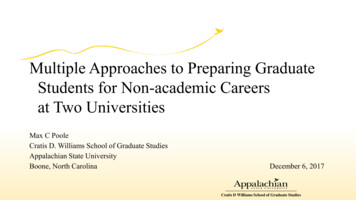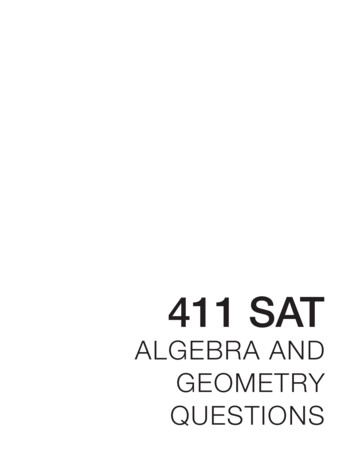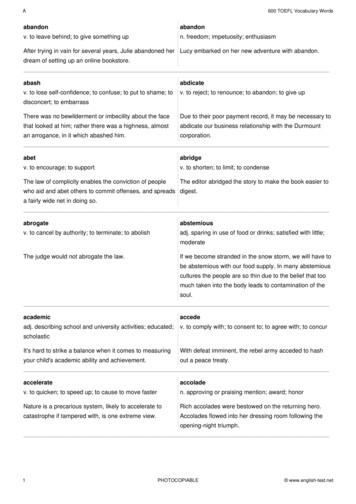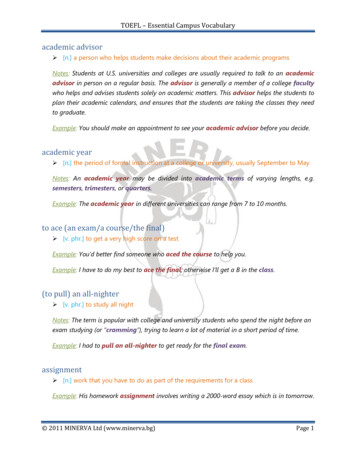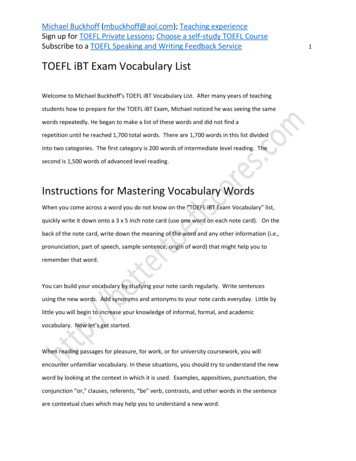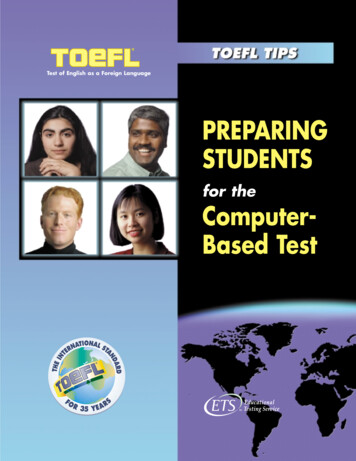
Transcription
Test of English as a Foreign LanguagePREPARINGSTUDENTSfor theComputerBased Test
Preparing Studentsfor theComputer-Based TestTOEFL Tips: Preparing Students for the Computer-Based Test has been created for ESL/EFL instructorsand educational advisors so they can help students prepare for the computer-based TOEFL test. It has beenprepared by Educational Testing Service (ETS), which develops and scores the TOEFL test. TOEFL Tipscan help students do their best on the test. However, it is not meant to replace the TOEFL InformationBulletin for Computer-Based Testing, which contains information students need to make appointmentsfor and become familiar with the test. If you wish to download this booklet, visit the TOEFL Web site atwww.toefl.org. To join the TOEFL mailing list (Internet or postal), enter the requested information atwww.toefl.org/edindx.html.
NOTE – This publication was prepared by TOEFL staff for educational purposes. It is available free of charge forreprinting to nonprofit educational and research organizations under the following provisions: Reproduction must be in printed paper format. The publication is not for Web or software use.It must be reprinted in its entirety.Distribution must be free of charge and for educational purposes.“Reprinted by permission of the TOEFL program, Educational Testing Service” must be printed on the front coverof the reprinted version.Permission requests to reprint free of charge should be made online (www.toefl.org/copyrigh.html) or sent to:Proprietary Rights OfficeEducational Testing ServiceRosedale RoadPrinceton, NJ 08541-0001 Educational Testing Service is an Equal Opportunity/Affirmative Action Employer.Copyright 1999 by Educational Testing Service. All rights reserved.EDUCATIONAL TESTING SERVICE, ETS, the ETS logo, POWERPREP, TOEFL, the TOEFL logo, TSE, and TWE areregistered trademarks of Educational Testing Service. The modernized ETS logo is a trademark of Educational Testing Service.SYLVAN is a registered trademark of Sylvan Learning Systems, Inc.
Table of ContentsIntroduction . . . . . . . . . . . . . . . . . . . . . . . . . . . . . . . . . . . . . . . . . . . . . . . . . . . . . .Benefits of TOEFL on computer . . . . . . . . . . . . . . . . . . . . . . . . . . . . . . . . . . .Section A: Steps in Preparing for the Computer-BasedTOEFL Test . . . . . . . . . . . . . . . . . . . . . . . . . . . . . . . . . . . . . . . . .56Step 1: Obtain TOEFL materials in order to begin test preparation . . . . . .77Step 2: Learn about the changes in the test format, how the test isstructured, and what each test section measures . . . . . . . . . . . . . . . .User-friendly tutorials . . . . . . . . . . . . . . . . . . . . . . . . . . . . . . . .Timing of test sections . . . . . . . . . . . . . . . . . . . . . . . . . . . . . . . .Test format . . . . . . . . . . . . . . . . . . . . . . . . . . . . . . . . . . . . . . . . .Listening section . . . . . . . . . . . . . . . . . . . . . . . . . . . . .Structure section . . . . . . . . . . . . . . . . . . . . . . . . . . . . . .Reading section . . . . . . . . . . . . . . . . . . . . . . . . . . . . . .Writing section . . . . . . . . . . . . . . . . . . . . . . . . . . . . . . .8891010121213Step 3: Learn how computer-based testing works and is scored . . . . . . . . . .Computer-adaptive testing . . . . . . . . . . . . . . . . . . . . . . . . . . . .How the computer-adaptive sections are scored . . . . . . . . . . . .Computerized nonadaptive testing . . . . . . . . . . . . . . . . . . . . . .14141515Step 4: Use test-taking strategies that will allow them to do their best . . . .General test-taking strategies . . . . . . . . . . . . . . . . . . . . . . . . . .Special strategies for each section . . . . . . . . . . . . . . . . . . . . . .For the Listening section . . . . . . . . . . . . . . . . . . . . . . .For the Structure section . . . . . . . . . . . . . . . . . . . . . . .For the Reading section . . . . . . . . . . . . . . . . . . . . . . . .For the Writing section . . . . . . . . . . . . . . . . . . . . . . . . .15151717181819Section B: Questions Frequently Asked by Students . . . . . .21Section C: More About the Essay . . . . . . . . . . . . . . . . . . . . . . . . . . . . .25262728Essay ratings. . . . . . . . . . . . . . . . . . . . . . . . . . . . . . . . . . . . . . . . . . . . . . . . . . . .Sample writing topics . . . . . . . . . . . . . . . . . . . . . . . . . . . . . . . . . . . . . . . . . . . .Sample essays . . . . . . . . . . . . . . . . . . . . . . . . . . . . . . . . . . . . . . . . . . . . . . . . . . .(continued)
Table of Contents (continued)Section D: About the Test Scores313131313233Concordance Tables.Using the concordance tables . . . . . . . . . . . . . . . . . . . . . . . . . . . . . . . . . . . . . .3535TOEFL Bulletins and Study Materials . . . . . . . . . . . . . . . . . . . . . .38How to Contact the TOEFL Program39.Score scales . . . . . . . . . . . . . . . . . . . . . . . . . . . . . . . . . . . . . . . . . . . . . . . . . . . . .New score requirements . . . . . . . . . . . . . . . . . . . . . . . . . . . . . . . . . . . . . . . . . .Score calculation . . . . . . . . . . . . . . . . . . . . . . . . . . . . . . . . . . . . . . . . . . . . . . . .Calculation of the Structure/Writing score . . . . . . . . . . . . . . . . . . . . . . . . . . .At the end of the exam . . . . . . . . . . . . . . . . . . . . . . . . . . . . . . . . . . . . . . . . . . . .
IntroductionEducational Testing Service (ETS ) is a nonprofit organization committed to the development andadministration of testing programs, and the creation of advisory and instructional services. In addition todeveloping tests, it supplies related services; for example, it scores the tests; records, stores, and reports testresults; performs validity and other statistical studies; and undertakes program research.The Test of English as a Foreign Language (TOEFL ) is designed to evaluate the English proficiencyof people whose native language is not English. TOEFL scores are required for admissions purposes bymore than 2,400 colleges and universities in the United States, Canada, and eighty other countries. Becausethe TOEFL test is independent of any curriculum or teaching method, the proficiency level of any test takercan be compared with that of any other student or group of students regardless of academic background orEnglish training.Since 1964, TOEFL test has been taken more than 11 million times in over 180 countries. In 1998TOEFL began its switch to computer. Over the years, many institutions had asked ETS for additionalproficiency information, including an estimate of candidates’ productive skills and ability to perform morecognitively challenging tasks. In redesigning the test for computer, the TOEFL program has taken animportant first step in that direction. The test consists of four sections: Listening, Structure, Reading, andWriting. Two sections, Listening and Structure, are computer-adaptive, which means questions are tailoredto examinees’ proficiency levels. Therefore, students will receive fewer questions that are too easy or toodifficult in those sections and candidates’ ability can be estimated more accurately. While the Structuresection features the same types of questions used in the paper-based TOEFL test, the Listening and Readingsections feature some new, innovative types of questions in addition to traditional multiple-choice questions.The Writing section, which assesses the ability to compose a written response to an assigned essay topic, isnow a required part of the test.In July 1998 students in these areas started taking the computer-based test (CBT):AfricaAustraliaEuropeLatin AmericaMiddle EastNorth AmericaSome of Asia:Brunei sSingaporeSri LankaAs a result of its first year of experience, the TOEFL program has made adjustments to its original CBTtesting plans by reintroducing paper-based testing on a temporary basis in several of the areas listed above.This helps provide access to the test in areas where it has been difficult to coordinate mobile computer-basedtesting.These “supplemental” paper-based administrations take place several times during the testing year; thenumber of administrations at a given center is dependent on historical test-taker patterns and volumes. TheTest of Written English (TWE ) is offered at each supplemental administration.The TOEFL Information Bulletin for Computer-Based Testing contains information on permanent andsupplemental testing centers. Because supplemental paper-based testing has been reintroduced to replacemobile computer testing, a Supplemental Bulletin is available for the affected areas. Both Bulletins can bedownloaded from the TOEFL Web site or can be obtained from local educational advisors and other Bulletindistribution offices.In October 2000 the computer-based test will be introduced in the areas listed below.BangladeshCambodiaHong hailandVietnamThe computer test will be introduced in the People’s Republic of China in 2002-03.5
Benefits of TOEFL on computerBy introducing the computer-based TOEFL test, ETS’s main goal is to provide a more complete pictureof a candidate’s proficiency in English: Assessment that is better tailored to each test taker’s ability level — a test that is appropriatelychallenging, with fewer questions that are too easy or too difficult An essay with every test administration Context-setting visuals and topic orientation during the Listening section Individual headphones and volume control Listening and reading sections that require candidates to demonstrate their comprehension byperforming specific tasksAdditional benefits include: Year-round testing in many locations Scheduling of appointments by phone Testing in comfortable, computer-equipped testing stations Enhanced test security Smaller proctor/examinee ratios Immediate viewing of unofficial scores on screen (except for essays) Opportunity to choose score recipients after seeing unofficial scores Faster reporting of official scores if examinees type the essay — scores sent from ETS about twoweeks after testing6
Section A: Steps in Preparing for theComputer-Based TOEFL TestNo single school, textbook, or teaching method is best to help prepare someone for the TOEFL test because itis not based on a special course of study. The test is designed to measure proficiency in English, which canonly be achieved after a relatively long period of study and practice.Instructors and advisors can help students prepare for and do their best on the computer-based TOEFLtest by helping them understand what the new exam is like. The process can be broken down into four steps.Steps in preparing for the computer-based TOEFL testStudents should1. obtain TOEFL materials in order to begin test preparation2. learn about the changes in the test format, how the test is structured, and what each test sectionmeasures3. learn how computer-based testing works and is scored4. use test-taking strategies that will allow them to do their bestStep 1: Obtain TOEFL materials in order to begin testpreparation.Students should obtain the TOEFL Information Bulletin for Computer-Based Testing. The Bulletin explainstest scheduling procedures and provides information about fees, test center locations, and identificationrequirements. It also describes the computer tutorials that precede every test session and includes sampletest questions.The TOEFL Sampler CD-ROM is also an important part of preparing for the test. It contains theanimated tutorials that precede the test and show test takers how to use a mouse, and the testing icons, andhow to scroll. Interactive test tutorials provide instructions for answering questions in the four sections of thetest. The Sampler also includes 67 practice questionsthat cover each section of the test. These questionsfamiliarize examinees with the test directions, formats,and question types.POWERPREP Software: Preparation for theComputer-Based TOEFL Test will be available sometime in the year 2000. This product will simulate theTOEFL computer testing experience. It will provide theactual tutorials delivered in the testing center, as well astwo timed tests automatically created — based on theuser’s ability level — from a pool of more than 1,200questions. At the end of each test, students will be ableto view their scores. POWERPREP will operate underthe same software used in actual test centers. Thispackage also will contain three essay topics for writingpractice and samples of actual essays written by TOEFLtest takers.7
Most of the questions on the computer-based TOEFL test are similar to those found in the paper-basedtest. Therefore, students can also practice with official TOEFL test preparation material designed for thepaper-based test: the TOEFL Test Preparation Kit and TOEFL Practice Tests, volumes 1 and 2. These productscontain official retired forms of the TOEFL test, with “real” TOEFL test questions.See page 38 for information about how to order the TOEFL Bulletin, TOEFL Sampler, POWERPREPsoftware (in the year 2000), and other official TOEFL test preparation materials.Step 2: Learn about the changes in the test format, how thetest is structured, and what each test section measures.The test format consists of tutorials and four required sections: Listening, Structure, Reading, and Writing.User-friendly tutorialsTo help examinees feel comfortable with test taking on the computer, each test is preceded by computerizedtutorials. The first three tutorials show examinees basic computer skills: how to use a mouse to point andclick, how to scroll, and how to use the testing icons. A tutorial at the beginning of each test section demonstrates how to answer the questions in that section. The Listening, Structure, and Reading tutorials are required.For those who decide to type the essay in the Writing section, there is also a word processing tutorial.The tutorials first present the skills needed to use the computer to answer questions by using simplelanguage and graphics, then demonstrate those skills with animation. Before they can go on, examinees mustsuccessfully complete exercises to show they have mastered each skill.Candidates can spend as much time as they need on these tutorials to feel comfortable with the test. Atany time during the test, examinees can click on the Help icon to review directions and information from thetutorials. However, the test clock does NOT stop while students access this function.The TOEFL program conducted an international research study on computer familiarity and found thatonce examinees had completed these tutorials there was no meaningful relationship between level of computerfamiliarity and performance on computer-based test questions. (The TOEFL Web site provides moreinformation about the computer familiarity study.)ClickingHow to ClickYou must press a mouse button once, then release it.Press Enter to see an example.8
Timing of test sectionsChart A shows the number of questions and the time limit for each section. Scores for all test takers arebased on the same number of questions. However, the number of questions in each section may varybecause additional, pretest questions may be randomly inserted for research purposes. The responses to thesepretest items do not count toward the test scores, but are used to estimate statistical properties for futureoperational use. This explains why the number of questions is expressed as a range. The time limit for eachsection varies according to the number of questions.Chart A: Computer-Based TOEFL Test FormatTest Portion# QuestionsTime LimitTutorials7 TutorialsUntimedListening30 to 5040 to 60 minutesStructure20 to 2515 to 20 minutesBREAK5 minutesReading44 to 5570 to 90 minutesWriting1 topic30 minutesThe total time spent in the test center is approximately four hours, depending on how quickly examineeswork through the tutorials and the test and whether pretest questions are included. The time limits aregenerous for most examinees and were determined after extensive research.Directions given at the beginning of each test section specify the time allowed in that section. The timeremaining in the section is displayed on a clock in the upper left corner of the screen; the number of questionsremaining is displayed in the upper right corner. The title bar display changes as examinees proceed throughthe section. For example, the title bar may show question 9 of 20 and 00:14 minutes, which means the testtaker is on the ninth question of 20 and 14 minutes remain for that section. (See the sample title bar screenbelow.) Examinees should check the number of questions and time limit before they begin the test. Theyshould also check their progress as they move along and pace themselves to finish all questions in the sectionbefore the time runs out. The clock can be displayed or hidden at any time, except during the last five minutes,when the time remaining is displayed automatically.The TOEFL Screens00:14TOEFL9 of 20This is question 9 out of a totalof 20 questions in this section.This shows there are 14 minutes left.Title BarThe title bar shows the time remaining test or sectiontitle question numberTime?HelpAnswerConfirmNextSee More9
Test formatThe computer-based TOEFL test features many of the question types used on the paper-based test and addsnew question types that can be offered only on computer.Listening sectionThe Listening section measures the candidate’s ability to understand English as it is spoken in North America.This section includes various stimuli — such as dialogues, short conversations, academic discussions, andexcerpts from lectures (also called minilectures) — and poses questions that test comprehension of mainideas, order of a process, supporting ideas, and important details, as well as the ability to make inferences andcategorize topics and objects. All stimuli are about academic topics and situations.After each stimulus is played, examinees both see and hear each question before they see the answerchoices. This encourages examinees to listen for main ideas. Five types of questions are found in the Listeningsection: traditional multiple-choice questions with four answer choicesquestions that require examinees to select a visual or part of a visualquestions with more than one answer (e.g., two answers out of four choices)questions that require examinees to order events or steps in a processquestions that require examinees to match objects or text to categoriesFileCopyright 䉷 1998, ETSListening - Practice Questions & Review14 of 27The professor briefly explains a process.Summarize the process by putting the events in order.Click on a sentence. Then click on the space where it belongs.Use each sentence only once.Fossilization takes place.An insect is trapped.TimeResin is produced by a tree.Resin becomes hard.1.Resin is produced by a tree.2.An insect is trapped.3.Resin becomes hard.4.Fossilization takes place.Volume?HelpAnswerConfirmNextVisuals accompany the listening stimuli to provide context and illustrate the topic. These visuals area new feature of the computer-based test that allow for varied and interactive stimuli that more closelyapproximate actual listening experiences, such as classroom lectures and campus conversations.The new question types require test takers to demonstrate their English proficiency by interacting withthe information presented to them. Examinees must use integrated language skills to manipulate graphics,categorize information, and order elements in a process, tasks that are similar to those required of students inthe classroom.The actual time needed to complete the Listening section is 40 to 60 minutes, but only 15 to 25 minutesof that time is for answering questions. The rest is for listening to the stimuli. The clock runs while examineesanswer questions but not while they listen to the stimuli. The listening stimuli and questions are presentedonly once, as in the paper-based test. However, the computer-based test is different from the paper-based test10
in the following ways: examinees see the visual as they listen, and they both see and hear the question beforethe answer choices appear. Also, the computer-based Listening section is self-paced. That is, examinees canchoose to go on to the next question when they are ready. This is different from the paper-based test, in whichthe pace of the Listening section is determined by the pace of the prerecorded tape.Copyright 䉷 1998, ETSListening - Practice Questions & ReviewFileVolumeTime?HelpAnswerConfirmNextThe Listening section consists of two parts: A and B. In Part A, examinees hear dialogues between twopeople. In the dialogues, each speaker takes one to two turns. Each dialogue is followed by one multiplechoice question with four answer choices. In Part B, examinees hear short conversations in which both of thespeakers take more than one turn. Each conversation lasts up to one minute and is followed by two to threemultiple-choice questions with four answer choices. Examinees should click on the best answer on the basisof what is stated or implied by the speakers.In Part B, examinees also hear academic discussions among two or more speakers, and minilecturesabout a variety of topics. Test takers do not need special background knowledge to answer the questionscorrectly; all the information needed to answer the questions is contained in the listening material presented.The discussions are up to two minutes in length; the minilectures are up to two and one-half minutes long.Both are followed by several questions. For most questions, examinees will click on the best of four possibleanswers, but some of the new types of questions listed on page 10 are included as well.Chart B: Listening Section FormatPartType of StimulusNumber of StimuliNumber of QuestionsADialogues11-171 eachBShort Conversations (up to 1 minute)2-32-3 eachBMinilectures (up to 2.5 minutes) andAcademic Discussions (up to 2 minutes)4-63-6 each11
Structure sectionThe Structure section measures the candidate’s ability to recognize language that is appropriate for standardwritten English. The language tested is formal, rather than conversational. The same two question types usedon the paper-based TOEFL test also appear on the computer-based test: questions in which examinees must complete a sentence using one of four choices provided questions in which they must identify one of four underlined words or phrases that is incorrectBoth question types are mixed randomly throughout the section rather than separated into twosubsections as in the paper-based test.Reading sectionThe Reading section measures the candidate’s ability to understand short passages similar in topic and style toacademic texts used in North American colleges and universities. This section tests comprehension of mainideas, factual information, inferences, and vocabulary (direct meaning, synonym, and antonym). It alsoassesses the ability to understand the rhetorical organization of a passage.Examinees read four to five passages of 250 to 350 words on academic subjects and answer 11 questionsabout each passage. As in the Listening section, test takers do not need any special background knowledge toanswer the questions in the Reading section correctly; all the information needed to answer the questions iscontained in the passages. Examinees must read through or scroll to the end of each passage before receivingquestions on that passage. The 70 to 90 minutes allotted for this section include the time spent reading thepassages and answering the questions.Chart C: Reading Section FormatLength of Passage250-350 wordsNumber of Passages4-5Number of Questions11 per passageThere are several question types in this section, most of them multiple-choice. New question typesinclude questions that require examinees to click on a word, phrase, sentence, or paragraph to answer questions that ask examinees to “insert a sentence” where it fits bestThe new question types require examinees to demonstrate their comprehension of a passage byperforming the following tasks: highlighting information in a passage to demonstrate their comprehension of main ideas and supportingdetails identifying paraphrases and inferences to demonstrate their ability to analyze meaning inserting an extra sentence into the appropriate part of a passage to demonstrate a more cognitivelycomplex aspect of comprehension: the ability to understand the organization of a passage, includingelements of coherence and cohesion. For example, examinees may be required to understand howtransitional words or pronouns are used to establish cohesion. Or examinees may be required to identifythe coherent, logical progression of ideas. identifying words or phrases with similar meanings, demonstrating an ability to comprehend discretelanguage segments and use context clues12
Copyright 䉷 1998, ETSReading Comprehension - Practice Question & ReviewFile6 of 20Questions 1 to 6More AvailableBut this was clearly not just a matter of thephysical advantages of early humans of erectposture and having the hands free to carry somethingelse.Fetching branches for a fire implies that theindividuals concerned thought about what they weredoing, and knew why they were doing it.Keepinga fire going implies foresight and care.Woodhad to be gathered, and perhaps even stored duringwet periods.Such activities did not comenaturally to early humans; they required learning anddiscipline.Especially when humans began tocollect fuel over larger distances, they devoted partof their energy to maintaining something outsidethemselves, something beyond their own immediateneeds. This is not to say they were acting“unselfishly.”Tending the fire was a form of“deferred gratification” or putting off the satisfactionof immediate need in planning for future needs, likethat which was later to become an essentialingredient in agriculture and livestock-raising.The following sentence can be added toparagraph 2.On the contrary, in caring for thefire they were also caring forthemselves.Where should it best fit in the paragraph?Click on the square ( ) to add thesentence to the paragraph.Paragraph 2 is marked with anarrow ().?HelpTimePreviousNextWriting sectionThe Writing section measures the candidate’s ability to write an essay in English on a single assigned topic,including the ability to generate, organize, and develop ideas; to support those ideas with examples orevidence; and to compose a response in standard written English. This section directly measures the testtaker’s ability to produce language and complements the information obtained from the Structure section.The essay is required on the computer-based test, not optional, as the Test of Written English is with thepaper-based test. The essay topic is chosen by the computer from a pool of topics published in the Bulletin andon the TOEFL Web site. Examinees must compose the essay in the 30-minute time limit and can eitherhandwrite the essay or type it on the computer. (The word-processing program used is Notepad-based anddoes not include tab, spell-check, or grammar-check functions.) Examinees are given scratch paper on whichthey can organize their thoughts. However, only essays written on the official answer sheet or typed into thecomputer are scored. (See Section C for the rating scale used to grade the essay.)Copyright 䉷 1998, ETSWriting Practice TopicsTOEFL - WritingFileRead the question below and type your response in the box.Do you agree or disagree with the following statement?Teachers should make learning enjoyable and fun for their students.Use reasons and specific examples to support your opinion.CutPasteUndo?TimeHelpAnswerConfirmNext13
Step 3: Learn how computer-based testing worksand is scored.Computer-adaptive testingThe computer-adaptive sections of the TOEFL test, Listening and Structure, are tailored to the individual testtaker. Each examinee receives a set of questions that meets the test design and is generally appropriate for hisor her proficiency level. Test design determines the total number of questions and the variety of questiontypes, as well as the subject matter presented (i.e., variety of topics for listening stimuli and reading passages).The computer-adaptive sections start with questions of moderate difficulty. As test takers answer eachquestion, the computer scores the question and uses that information, as well as the responses to previousquestions, to determine which question is presented next. As long as candidates respond correctly, thecomputer typically selects a next question of greater or equal difficulty. In contrast, if they answer a questionincorrectly, the computer typically selects a question of lesser or equal difficulty. The computer isprogrammed to choose questions that meet the test design as it continuously adjusts to find questions ofappropriate difficulty for test takers of all performance levels.This means that different test takers will be given different, but comparable, questions. However,examinees should not feel alarmed if they receive slightly easier questions than expected; it may mean thatthe computer is meeting the test design. All examinees must answer a predetermined number of questionsfrom each of the specified content categories, and some of these categories naturally involve less difficultmaterial. Thus, even individuals who receive high scores are typically required to answer some relativelyeasy questions.However, with computer-adaptive testing, candidates receive fewer questions that are either too easy ortoo difficult for them. The computer is constantly probing to confirm just how high each examinee canperform; this means that the test is appropriately ch
test. Therefore, students can also practice with official TOEFL test preparation material designed for the paper-based test: the TOEFL Test Preparation Kit and TOEFL Practice Tests, v olumes 1 and 2. These products contain official retired forms of the TOEFL test
